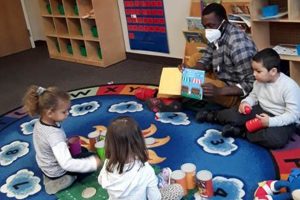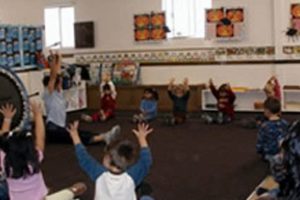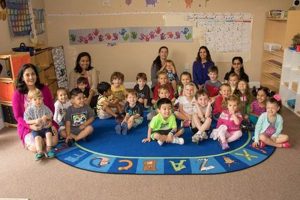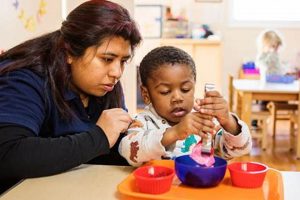Choosing an early childhood education program involves considering various pedagogical approaches. One common deliberation for parents is selecting between a Montessori environment and a traditional preschool setting. These two models differ significantly in their philosophies, teaching methodologies, and learning environments. A traditional preschool typically follows a structured curriculum with teacher-directed activities, focusing on social-emotional development and introducing basic academic concepts. Montessori education, on the other hand, emphasizes self-directed learning, hands-on exploration, and individualized pacing within a carefully prepared environment featuring specialized materials. Children in Montessori classrooms typically work independently or in small groups, choosing activities that align with their interests and developmental stage.
The contrasting approaches to early childhood education offered by these distinct models reflect different educational values and desired outcomes. Traditional preschools often prioritize school readiness, focusing on developing foundational skills necessary for navigating a conventional classroom setting. The emphasis is typically placed on group activities, structured learning, and teacher guidance. Montessori education, originating with the work of Dr. Maria Montessori, values fostering independence, intrinsic motivation, and a love for learning through exploration and discovery. This approach encourages children to pursue their interests at their own pace, fostering a sense of self-reliance and a lifelong love for learning.
Understanding these core differences is paramount for parents as they seek the most suitable early childhood education experience for their children. The following sections will explore the specific characteristics of each model, examining their respective curricula, classroom environments, teacher roles, and potential benefits. This exploration will provide a comprehensive framework for informed decision-making and enable parents to choose the educational pathway best aligned with their child’s unique needs and learning style.
Tips for Choosing Between Montessori and Traditional Preschool
Selecting the optimal early childhood education environment requires careful consideration of a child’s individual needs and learning style. The following tips offer guidance for navigating the decision-making process when considering Montessori and traditional preschool programs.
Tip 1: Observe the Classroom Environment. Visiting both Montessori and traditional preschool classrooms provides valuable insights. Observing the learning environment firsthand can illuminate the differences in teaching approaches and overall atmosphere. Look for a classroom that feels engaging and supportive of children’s exploration and development.
Tip 2: Consider the Child’s Learning Style. Some children thrive in structured environments with clear expectations, while others benefit from greater autonomy and self-directed learning. Reflect on the child’s personality, interests, and preferred learning methods when evaluating different program types.
Tip 3: Evaluate the Curriculum. Examine the curriculum’s focus and how it aligns with desired learning outcomes. Traditional preschool curricula often emphasize pre-academic skills and school readiness. Montessori curricula, conversely, prioritize holistic development and hands-on learning experiences.
Tip 4: Understand Teacher Roles. The role of the teacher differs significantly in Montessori and traditional preschool settings. In traditional settings, teachers typically lead activities and provide direct instruction. Montessori teachers act as guides, facilitating children’s independent exploration and learning.
Tip 5: Assess the Level of Parental Involvement. Different programs offer varying levels of parental involvement. Consider the desired level of engagement and communication with the school community when making a decision.
Tip 6: Consider Long-Term Educational Goals. Think beyond preschool and consider how the chosen approach might align with future educational aspirations. Reflect on the values and learning styles that will best support the child’s long-term academic success.
Tip 7: Factor in Practical Considerations. Practical aspects such as location, cost, and program schedule play a crucial role. Ensure the chosen program aligns with family logistics and budgetary constraints.
By considering these factors, parents can gain a clearer understanding of the distinctions between Montessori and traditional preschool programs, enabling a well-informed decision that supports the child’s individual needs and fosters a positive early learning experience. The subsequent sections will provide a more detailed examination of these considerations, offering deeper insights into each program type.
1. Learning Philosophy
Learning philosophies form the bedrock of educational approaches, significantly influencing the pedagogical methods, curriculum design, and overall learning environment. When considering the “Montessori versus preschool” dilemma, understanding the contrasting learning philosophies is paramount. Montessori education is grounded in the belief that children possess an innate drive to learn and develop independently. This philosophy emphasizes self-directed learning, hands-on exploration, and individualized pacing. Children are encouraged to follow their interests and learn through experience within a carefully prepared environment featuring specialized materials. Traditional preschools, conversely, often adopt a more teacher-directed approach, where instructors guide learning through structured activities and pre-determined curricula. The emphasis is typically placed on developing school readiness skills, such as following instructions, working in groups, and acquiring foundational literacy and numeracy concepts.
This divergence in learning philosophies has practical implications for the classroom experience. In a Montessori setting, one might observe children independently choosing activities from a range of options, working at their own pace, and engaging in self-assessment. A traditional preschool classroom might feature teacher-led group activities, structured lessons, and a greater emphasis on direct instruction. For example, a Montessori child might explore mathematical concepts through manipulating concrete materials like the Golden Beads, while a preschool child might learn similar concepts through teacher-guided worksheets or group exercises. The impact of these different approaches extends beyond specific activities, shaping the child’s overall attitude towards learning, their sense of independence, and their development of problem-solving skills.
Ultimately, the choice between these two approaches hinges on a family’s educational values and the individual child’s learning style. Recognizing the distinct learning philosophies underpinning Montessori and traditional preschools empowers parents to make informed decisions. Selecting an environment aligned with a child’s natural inclinations and desired learning outcomes can significantly impact their early educational journey and foster a lifelong love for learning. The key lies in understanding that there is no universally superior approach; the best fit depends on the individual child and their unique needs.
2. Curriculum Structure
Curriculum structure distinguishes Montessori and traditional preschool programs. Montessori classrooms utilize a prepared environment with self-correcting materials encouraging exploration across various subjects. Children choose activities based on individual interests and developmental readiness, fostering self-directed learning. A three-year-old might work with sandpaper letters to develop pre-writing skills, while a five-year-old explores complex mathematical concepts using the Golden Beads. This individualized approach contrasts sharply with the structured, often theme-based curriculum typical of traditional preschools. These programs generally follow a predetermined scope and sequence, with teachers leading group activities focused on specific learning objectives. For instance, a preschool class might dedicate a week to learning about the ocean, incorporating art, music, and literacy activities related to the theme. This structure aims to introduce fundamental academic concepts and prepare children for a more formal learning environment.
The impact of curriculum structure extends beyond the immediate learning experience. Montessori’s child-centered approach fosters independence, self-regulation, and a love of learning. The freedom to choose activities allows children to delve into areas of interest, promoting deeper understanding and sustained engagement. Conversely, the structured nature of traditional preschools emphasizes social skills, group dynamics, and adherence to routines, often considered crucial for kindergarten readiness. This approach provides a consistent framework and predictable learning experiences, which can be beneficial for some children. For example, circle time activities in a traditional preschool promote listening skills and social interaction, while independent work periods in a Montessori classroom cultivate focus and self-reliance.
Choosing between these curricular structures requires careful consideration of a child’s learning style and developmental needs. While the Montessori approach benefits self-motivated, independent learners, the structured environment of a traditional preschool may better suit children who thrive on routine and explicit instruction. Understanding these differing structures, their associated pedagogical approaches, and their potential impact on children’s learning styles is critical for selecting an appropriate early childhood education program. No single structure is inherently superior; the optimal choice depends on the individual child and their unique learning preferences. This understanding underscores the importance of thoughtful consideration and careful program selection in aligning educational experiences with individual needs.
3. Teacher's Role
The teacher’s role constitutes a pivotal distinction between Montessori and traditional preschool settings, directly impacting the learning experience. In Montessori classrooms, teachers act as facilitators or guides, observing children, preparing the environment, and offering individualized support as needed. They introduce materials and concepts, then step back to allow children to explore independently, fostering self-reliance and intrinsic motivation. For example, a Montessori teacher might demonstrate how to use a specific manipulative for mathematical exploration, then allow the child to experiment with it independently, providing guidance only when necessary. This contrasts sharply with the role of the teacher in a traditional preschool, where direct instruction and group activities are prominent. Teachers typically lead structured lessons, deliver information to the whole class, and manage classroom routines. A preschool teacher might lead a circle time activity involving story reading and songs, followed by a teacher-directed art project related to the story’s theme. This difference influences not only the delivery of information but also the child’s learning agency and approach to problem-solving.
The implications of these contrasting roles extend beyond pedagogical approaches. Montessori teachers cultivate independence by empowering children to make choices, manage their time, and pursue their interests. They observe individual learning styles and tailor their guidance accordingly. This approach fosters self-regulation and a sense of ownership over the learning process. In contrast, traditional preschool teachers often emphasize adherence to established routines and group activities, promoting social skills and preparing children for the structured environment of elementary school. This approach prioritizes collaborative learning, shared experiences, and the development of classroom management skills. Consequently, the teacher’s role shapes the classroom culture and influences how children interact with their peers, the materials, and the learning process itself. Consider a child struggling with a puzzle in a Montessori setting; the teacher might offer subtle guidance or suggest alternative strategies, encouraging the child to persevere independently. In a traditional preschool, the teacher might intervene more directly, demonstrating the solution or pairing the child with a classmate for assistance.
Understanding the nuances of the teacher’s role in each setting is crucial for making informed decisions about early childhood education. The choice between a facilitator and a direct instructor depends on the individual child’s learning preferences and the desired educational outcomes. While some children thrive under direct guidance and benefit from structured activities, others flourish in an environment where independence and self-directed exploration are encouraged. The teacher’s role significantly impacts not only the acquisition of knowledge but also the development of essential life skills, including problem-solving, self-regulation, and social interaction. Choosing the right educational environment requires careful consideration of the teacher’s role and its alignment with a child’s unique learning style and developmental needs. Recognizing the long-term implications of this decision emphasizes the importance of understanding these different pedagogical approaches.
4. Learning Environment
Learning environments play a crucial role in shaping a child’s early educational experiences. The “Montessori versus preschool” discussion hinges significantly on the distinct environments each approach offers. Montessori classrooms are characterized by carefully prepared spaces designed to foster independence, exploration, and self-directed learning. These environments typically feature open shelving with accessible materials arranged according to subject area, allowing children to freely choose activities that align with their interests and developmental stage. Materials are designed to be self-correcting, enabling children to learn from their mistakes independently. For example, a child working with a puzzle map of the world can readily see if a piece is misplaced, fostering problem-solving skills and self-assessment. This contrasts with traditional preschool classrooms, often organized around teacher-directed activities and group learning. These environments might feature designated areas for circle time, art projects, and free play, with materials often stored out of reach and distributed by the teacher. This structure promotes a sense of order and routine, emphasizing teacher guidance and group interaction. One might observe a preschool teacher leading a craft activity with pre-portioned materials distributed to each child at a communal table, fostering collaborative skills and adherence to instructions.
The impact of these distinct environments extends beyond the immediate learning experience. The Montessori environment encourages self-regulation, intrinsic motivation, and a sense of ownership over the learning process. Children develop independence by choosing their activities, managing their time, and pursuing their interests at their own pace. This self-directed exploration fosters a deeper understanding of concepts and a lifelong love for learning. The structured environment of a traditional preschool, on the other hand, emphasizes social interaction, adherence to routines, and school readiness skills. Children learn to follow instructions, work collaboratively, and transition between activities, preparing them for the structured setting of elementary school. Consider the difference between a Montessori child independently selecting a book from the classroom library and reading quietly in a designated corner and a preschool child participating in a teacher-led story time session with the whole class. These experiences cultivate different skill sets and learning styles, highlighting the significance of the learning environment in shaping a child’s educational journey.
Choosing the right environment requires careful consideration of a child’s individual learning style and developmental needs. While the Montessori environment benefits self-motivated and independent learners, the structured setting of a traditional preschool might be more suitable for children who thrive on routine and direct instruction. Understanding these differing environments, their underlying philosophies, and their potential impact on a child’s learning is essential for making informed decisions about early childhood education. The long-term implications of this decision underscore the importance of aligning the learning environment with a child’s unique personality and learning preferences, fostering a positive and productive early learning experience. No single environment is inherently superior; the optimal choice depends on the individual child and their specific needs.
5. Social Development
Social development in early childhood is a crucial aspect of growth, impacting future interactions and learning. The “Montessori versus preschool” discussion often includes how each approach fosters social skills. Montessori environments, characterized by mixed-age classrooms, offer opportunities for children to learn from and mentor one another. Older children reinforce their understanding by guiding younger peers, while younger children observe and emulate more advanced skills. This dynamic fosters a sense of community and shared responsibility. For instance, a five-year-old might assist a three-year-old in fastening a dressing frame, developing patience and leadership skills while the younger child gains practical life skills and confidence. While collaboration is encouraged, much of the Montessori curriculum emphasizes independent work, fostering self-reliance and concentration. This contrasts with traditional preschool settings, which often prioritize group activities and structured play designed to promote social interaction. Circle time, shared art projects, and group games are common features, explicitly targeting the development of social skills like sharing, turn-taking, and conflict resolution. A preschool teacher might organize a group activity where children share a limited number of toys, explicitly teaching the concept of sharing and negotiating access.
The contrasting approaches to social development reflect differing educational philosophies. Montessori environments emphasize the development of self-regulation and independence as a foundation for positive social interactions. The belief is that children who are confident in their abilities and comfortable working independently are better equipped to engage in collaborative activities. Traditional preschools, on the other hand, often focus on direct instruction of social skills through structured activities and teacher guidance. This approach aims to equip children with explicit strategies for navigating social situations. Consider a conflict arising between two children over a toy. In a Montessori classroom, the teacher might observe the interaction and, if necessary, facilitate a resolution by guiding the children towards negotiation and compromise. In a traditional preschool, the teacher might intervene more directly, implementing pre-established classroom rules and mediating the conflict. These different responses reflect the varying emphasis on direct instruction versus self-directed learning in social development.
Understanding these nuanced approaches to social development is crucial for selecting an appropriate early childhood education environment. While both Montessori and traditional preschools aim to foster social skills, they employ different strategies and prioritize different aspects of social learning. Montessori emphasizes indirect learning through mixed-age interactions and self-directed activities, while traditional preschools focus on direct instruction and structured group experiences. The optimal choice depends on a child’s individual personality, learning style, and social needs. Recognizing the long-term implications of these early social experiences underscores the importance of selecting an environment that provides the appropriate level of support and guidance for each child’s social development. The effectiveness of each approach depends on the individual child and their unique developmental trajectory, highlighting the need for careful consideration and observation in choosing the right environment.
6. Cost and Accessibility
Cost and accessibility represent significant factors influencing parental decisions regarding early childhood education. Disparities in program availability and tuition fees between Montessori and traditional preschools often play a decisive role in the selection process. Understanding these financial and logistical considerations is crucial for making informed choices aligned with family resources and priorities. Exploring these aspects clarifies the trade-offs inherent in selecting between different educational approaches.
- Tuition Fees and Program Funding
Montessori programs, frequently operating as private institutions, typically command higher tuition fees than publicly funded or subsidized traditional preschool programs. This difference in funding models directly impacts affordability and accessibility. For example, a Montessori preschool might require annual tuition exceeding $10,000, while a state-funded preschool program might be free or offer sliding-scale fees based on family income. This financial disparity limits access to Montessori education for many families, regardless of pedagogical preferences.
- Geographic Availability and Program Density
Traditional preschools tend to be more widely available geographically, particularly in densely populated areas. Montessori programs, while growing in popularity, remain less prevalent. This difference in program density translates to practical challenges for families seeking Montessori education. Families in rural or underserved communities might lack access to any Montessori programs, forcing a choice between traditional preschool or alternative childcare arrangements, irrespective of educational philosophy preferences. Even in urban areas, the limited number of Montessori schools might result in long waiting lists or extended commutes, creating logistical barriers.
- Financial Aid and Scholarship Opportunities
While some Montessori schools offer financial aid or scholarship programs, these opportunities are often limited and highly competitive. Traditional preschools, particularly publicly funded programs, are more likely to offer subsidized tuition based on family income. This difference in financial assistance availability further exacerbates the accessibility gap between the two approaches. A family might qualify for free or reduced-cost tuition at a traditional preschool but face full tuition costs at a Montessori program, creating a financial barrier regardless of educational philosophy alignment.
- Hidden Costs and Material Fees
Beyond tuition, additional costs associated with each program type should be considered. Montessori programs might require specific materials or uniforms, adding to the overall financial burden. Traditional preschools might have fundraising expectations or fees for extracurricular activities. These hidden costs, while sometimes seemingly small, can accumulate and impact overall affordability. A Montessori school might require specialized learning materials purchased through the school, increasing the financial commitment beyond tuition, while a traditional preschool might request regular contributions for classroom supplies or field trips, impacting family budgets.
Ultimately, the decision between Montessori and traditional preschool often involves balancing educational philosophy preferences with financial realities and logistical constraints. While cost and accessibility should not be the sole determinants, they represent practical considerations that significantly influence the decision-making process. Recognizing these financial and logistical factors allows families to navigate the “Montessori versus preschool” dilemma with a realistic understanding of the trade-offs involved, ensuring an informed decision aligned with both educational values and available resources. This holistic approach facilitates a choice that best serves the individual child’s needs within the family’s practical constraints.
Frequently Asked Questions
Choosing between Montessori and traditional preschool often generates numerous questions. This section addresses common inquiries, providing clear and concise information to assist families navigating this important decision.
Question 1: Which approach better prepares children for kindergarten?
Both Montessori and traditional preschools aim to equip children with skills necessary for kindergarten. Montessori emphasizes independence, self-regulation, and problem-solving, while traditional preschools focus on social skills, group activities, and pre-academic learning. “Kindergarten readiness” encompasses various skills, and the best approach depends on the individual child’s needs and the specific kindergarten program.
Question 2: Is one approach demonstrably superior academically?
Research comparing academic outcomes in Montessori and traditional preschool settings yields mixed results. Some studies suggest Montessori students demonstrate advantages in specific areas, such as problem-solving and critical thinking, while others find no significant differences. Academic success depends on numerous factors beyond preschool pedagogy, including individual learning styles, family support, and subsequent educational experiences.
Question 3: How do the classroom environments differ?
Montessori classrooms are typically characterized by open spaces with self-correcting materials designed for independent exploration. Traditional preschool classrooms often feature designated areas for specific activities and teacher-directed learning. The choice depends on the child’s learning style and preference for structured versus self-directed activities.
Question 4: What is the role of the teacher in each setting?
Montessori teachers act as facilitators, guiding children’s exploration and providing support as needed. Traditional preschool teachers typically lead group activities and deliver direct instruction. This distinction impacts the child’s learning agency and the development of independence versus structured learning habits.
Question 5: Do children in Montessori programs develop sufficient social skills?
While Montessori programs emphasize independent work, they also provide opportunities for social interaction through mixed-age classrooms and collaborative activities. Children learn social skills by interacting with peers of different ages and engaging in shared responsibilities within the classroom community. Socialization occurs differently than in traditional preschools but is nonetheless a crucial aspect of the Montessori approach.
Question 6: Which approach is more expensive?
Montessori programs, often operating as private schools, typically have higher tuition fees than traditional preschools, many of which receive public funding or subsidies. This cost difference significantly impacts accessibility and necessitates careful consideration of family budgets and available financial aid options.
Careful consideration of individual learning styles, family values, and practical constraints is crucial. Understanding the nuances of each approach enables informed decisions that align with a child’s unique needs and family priorities.
The next section will explore specific examples of Montessori and traditional preschool activities, offering further insights into the practical application of each pedagogical approach.
Montessori Versus Preschool
Choosing between a Montessori and traditional preschool environment requires careful deliberation of distinct educational philosophies, pedagogical approaches, and practical considerations. This exploration has highlighted key differences in curriculum structure, teacher roles, learning environments, approaches to social development, and cost and accessibility. Montessori education emphasizes self-directed learning, hands-on exploration, and individualized pacing within a carefully prepared environment. Traditional preschools, conversely, often prioritize structured activities, teacher-directed learning, and school readiness skills. Neither approach is inherently superior; the optimal choice depends on the individual child’s learning style, developmental needs, and family values. Understanding these core distinctions empowers informed decision-making, aligning educational experiences with individual needs.
The decision regarding early childhood education holds profound implications for a child’s future learning journey. Selecting an environment that nurtures a child’s innate curiosity, fosters a love for learning, and cultivates essential life skills provides a strong foundation for future academic and personal success. Thoughtful consideration of the “Montessori versus preschool” dilemma, informed by the insights presented here, enables families to make choices aligned with their child’s unique needs and long-term educational aspirations. This careful deliberation empowers families to embark on an educational path that fosters growth, independence, and a lifelong love for learning.







